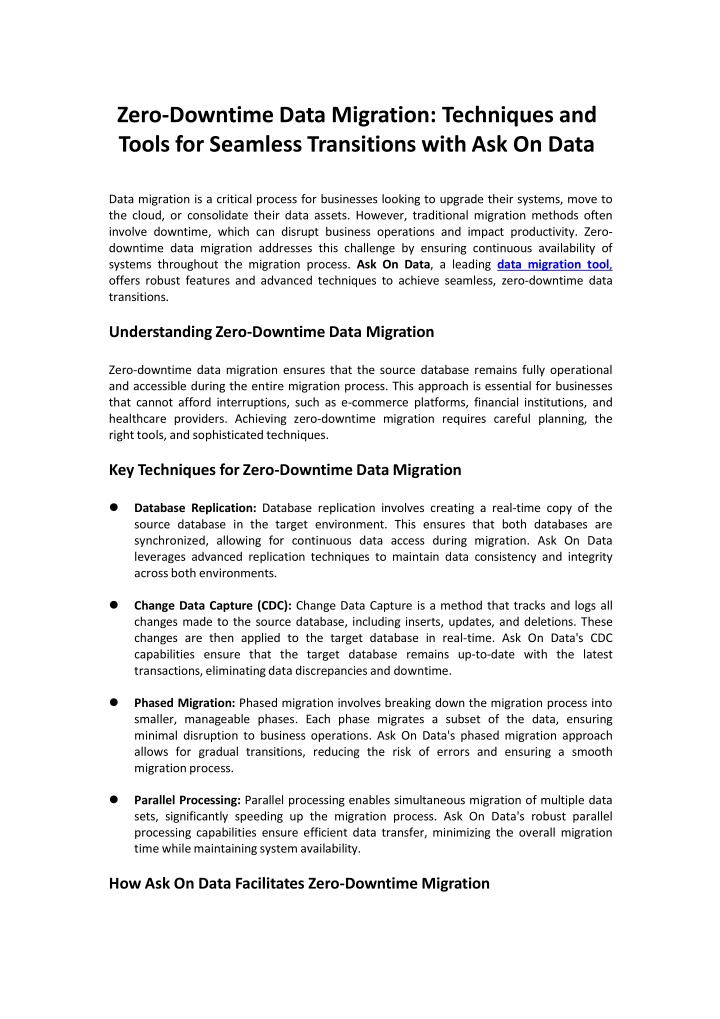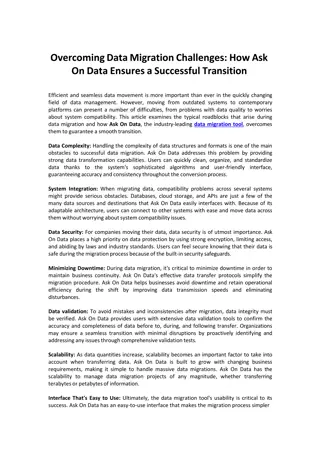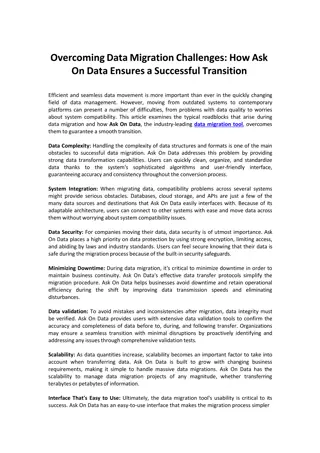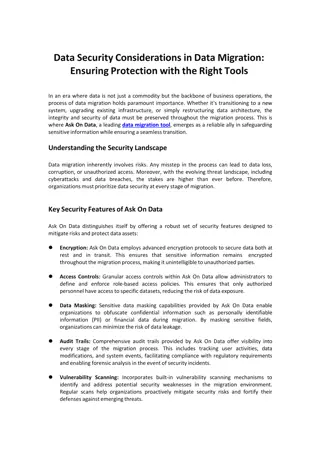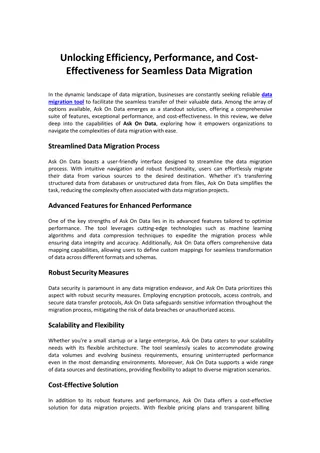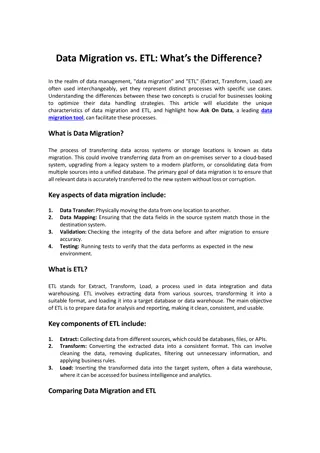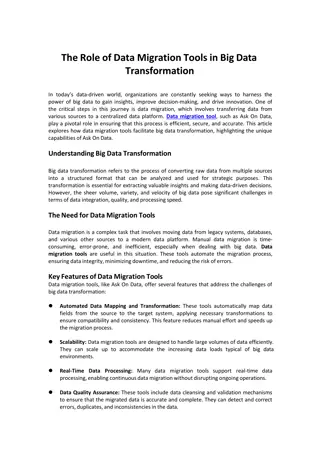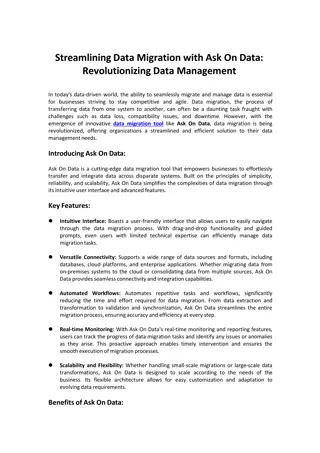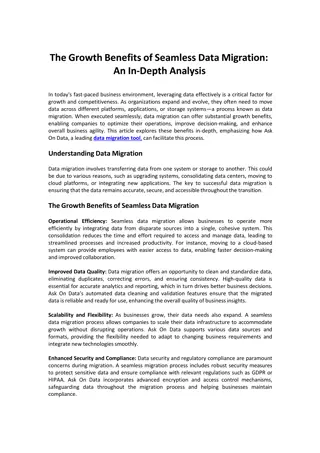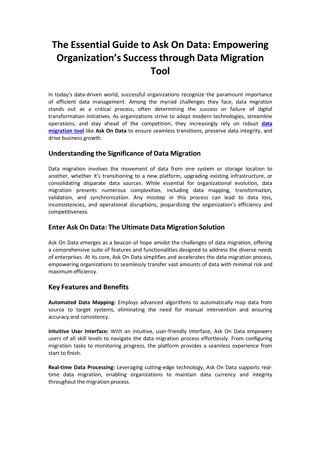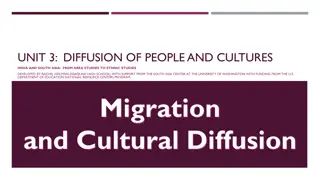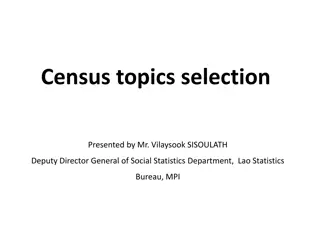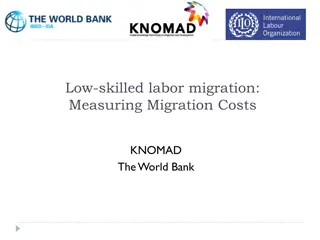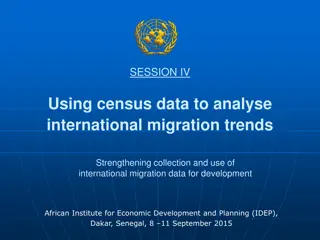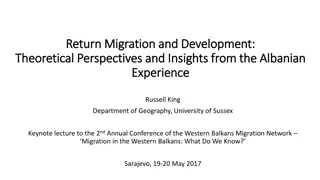Data Migration Tools and Techniques for Seamless Transitions with Ask On Data
Data migration is a critical process for businesses looking to upgrade their systems, move to the cloud, or consolidate their data assets. However, traditional migration methods often involve downtime, which can disrupt business operations and impact productivity. Zero-downtime data migration addresses this challenge by ensuring continuous availability of systems throughout the migration process. Ask On Data, a leading data migration tool, offers robust features and advanced techniques to achieve seamless, zero-downtime data transitions.
Download Presentation

Please find below an Image/Link to download the presentation.
The content on the website is provided AS IS for your information and personal use only. It may not be sold, licensed, or shared on other websites without obtaining consent from the author.If you encounter any issues during the download, it is possible that the publisher has removed the file from their server.
You are allowed to download the files provided on this website for personal or commercial use, subject to the condition that they are used lawfully. All files are the property of their respective owners.
The content on the website is provided AS IS for your information and personal use only. It may not be sold, licensed, or shared on other websites without obtaining consent from the author.
E N D
Presentation Transcript
Zero-Downtime Data Migration: Techniques and Tools for Seamless Transitions withAsk On Data Data migration is a critical process for businesses looking to upgrade their systems, move to the cloud, or consolidate their data assets. However, traditional migration methods often involve downtime, which can disrupt business operations and impact productivity. Zero- downtime data migration addresses this challenge by ensuring continuous availability of systems throughout the migration process. Ask On Data, a leading data migration tool, offers robust features and advanced techniques to achieve seamless, zero-downtime data transitions. UnderstandingZero-Downtime Data Migration Zero-downtime data migration ensures that the source database remains fully operational and accessible during the entire migration process. This approach is essential for businesses that cannot afford interruptions, such as e-commerce platforms, financial institutions, and healthcare providers. Achieving zero-downtime migration requires careful planning, the righttools,andsophisticatedtechniques. Key Techniques forZero-Downtime Data Migration Database Replication: Database replication involves creating a real-time copy of the source database in the target environment. This ensures that both databases are synchronized, allowing for continuous data access during migration. Ask On Data leverages advanced replication techniques to maintain data consistency and integrity acrossbothenvironments. Change Data Capture (CDC): Change Data Capture is a method that tracks and logs all changes made to the source database, including inserts, updates, and deletions. These changes are then applied to the target database in real-time. Ask On Data's CDC capabilities ensure that the target database remains up-to-date with the latest transactions,eliminatingdatadiscrepanciesand downtime. Phased Migration: Phased migration involves breaking down the migration process into smaller, manageable phases. Each phase migrates a subset of the data, ensuring minimal disruption to business operations. Ask On Data's phased migration approach allows for gradual transitions, reducing the risk of errors and ensuring a smooth migrationprocess. Parallel Processing: Parallel processing enables simultaneous migration of multiple data sets, significantly speeding up the migration process. Ask On Data's robust parallel processing capabilities ensure efficient data transfer, minimizing the overall migration time whilemaintainingsystemavailability. How Ask On Data Facilitates Zero-Downtime Migration
Ask On Data is designed to simplify and streamline the data migration process, offering severalfeaturesthatsupportzero-downtime transitions. User-Friendly Interface: Ask On Data's intuitive interface, powered by natural language processing (NLP), allows users to configure and manage the migration process using simple commands. This reduces the complexity of data migration, making it accessible to userswith varyinglevelsof technicalexpertise. Advanced Error Handling and Recovery: Ask On Data includes robust error-handling mechanisms that detect and resolve issues in real-time. This ensures data integrity and reliability throughout the migration process. In case of any failures, Ask On Data's recovery features enablequick restoration,maintainingcontinuoussystem availability. Scalable and Flexible Solutions: Ask On Data is scalable, accommodating businesses of all sizes and data volumes. Its flexible architecture supports various data sources and destinations,makingit an idealchoicefor diversemigrationneeds. Comprehensive Support and Documentation: Ask On Data provides detailed documentation and comprehensive support to guide users through the migration process. This ensures that businesses can effectively utilize the tool's features and achieve successfulzero-downtimemigrations. Benefits of Zero-DowntimeMigration withAskOnData Continuous Business Operations: By ensuring that systems remain operational throughout the migration process, Ask On Data minimizes disruptions and maintains businesscontinuity.Thisis crucial for industriesthat rely on constantdata availability. Reduced Risk of Data Loss: Ask On Data's advanced techniques and robust error- handling features reduce the risk of data loss during migration, ensuring data integrity and consistency. Enhanced Efficiency and Productivity: Zero-downtime migration with Ask On Data enables businesses to upgrade their systems and infrastructure without impacting productivity. This leads to smoother transitions and faster realization of the benefits of new technologies. Conclusion Zero-downtime data migration is essential for businesses that cannot afford interruptions in their operations. Ask On Data offers a comprehensive solution for achieving seamless transitions with its advanced techniques and user-friendly features. By leveraging Ask On Data, businesses can ensure continuous availability of their systems, maintain data integrity, and achieve efficient,risk-freemigrations.
